整数规划解法-匈牙利 算法部分
- 格式:ppt
- 大小:656.00 KB
- 文档页数:64
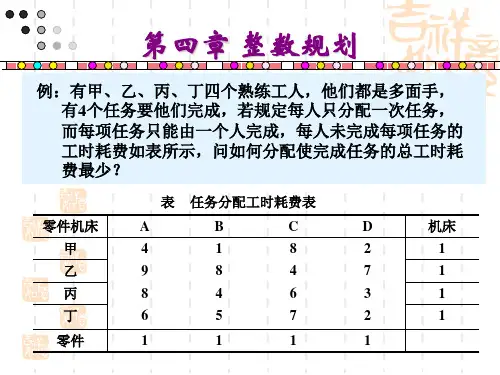
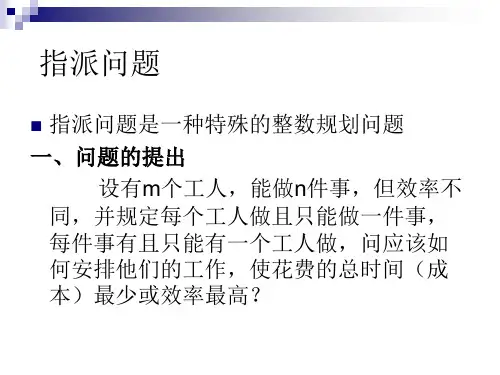
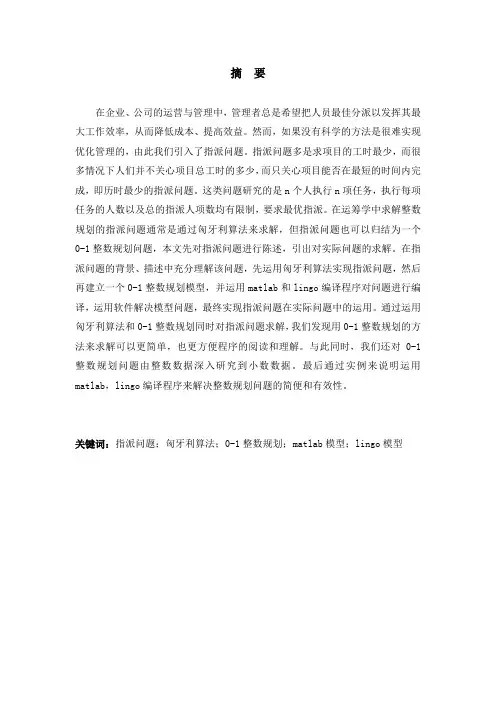
摘要在企业、公司的运营与管理中,管理者总是希望把人员最佳分派以发挥其最大工作效率,从而降低成本、提高效益。
然而,如果没有科学的方法是很难实现优化管理的,由此我们引入了指派问题。
指派问题多是求项目的工时最少,而很多情况下人们并不关心项目总工时的多少,而只关心项目能否在最短的时间内完成,即历时最少的指派问题。
这类问题研究的是n个人执行n项任务,执行每项任务的人数以及总的指派人项数均有限制,要求最优指派。
在运筹学中求解整数规划的指派问题通常是通过匈牙利算法来求解,但指派问题也可以归结为一个0-1整数规划问题,本文先对指派问题进行陈述,引出对实际问题的求解。
在指派问题的背景、描述中充分理解该问题,先运用匈牙利算法实现指派问题,然后再建立一个0-1整数规划模型,并运用matlab和lingo编译程序对问题进行编译,运用软件解决模型问题,最终实现指派问题在实际问题中的运用。
通过运用匈牙利算法和0-1整数规划同时对指派问题求解,我们发现用0-1整数规划的方法来求解可以更简单,也更方便程序的阅读和理解。
与此同时,我们还对0-1整数规划问题由整数数据深入研究到小数数据。
最后通过实例来说明运用matlab,lingo编译程序来解决整数规划问题的简便和有效性。
关键词:指派问题;匈牙利算法;0-1整数规划;matlab模型;lingo模型AbstractIn business, the company's operations and management, managers always want the best distribution of the staff to maximize their efficiency, reduce costs and improve efficiency. However, if there is no scientific method is difficult to achieve optimal management, which we introduced the assignment problem. Multi-assignment problem is to get the project working hours at least, and in many cases people do not care about how much the total project work, but only care about whether the project can be completed within the shortest possible time, that lasted for at least the assignment problem. Such problems is the n individual execution of tasks n, the number of people to perform each task and assign the total number of items are restricted to two people, requiring the optimal assignment. Integer programming in operations research for solving the assignment problem is usually solved by Hungarian algorithm, but the assignment problem can be reduced to a 0-1 integer programming problem, this paper first to make a statement on the assignment problem, leads to the solution of practical problems. Assignment problem in the background to fully understand the problem description, the first assignment problem using Hungarian algorithm, and then a 0-1 integer programming model and compiler using matlab and the lingo of the problem to be compiled using the software solution model problem Ultimately in the assignment of the application in practical problems. By using the Hungarian algorithm and the 0-1 integer programming to solve assignment problems simultaneously, we found that 0-1 integer programming method to solve a more simple and easier to read and understand the program. At the same time, we also 0-1 integer programming problem in-depth study by the integer data to a decimal data. Finally, an example to illustrate the use of matlab, lingo compiler to solve the integer programming problem is simple and effective.Keywords:assignment problem; Hungarian algorithm; 0-1 integer programming;matlab model; lingo model目录1. 问题陈述 (1)2. 指派问题的背景 (1)3. 指派问题的描述 (1)3.1 指派问题的一般形式 (1)3.2 问题的数学模型一般形式 (2)3.3 目标函数极大化的指派问题 (2)4.指派问题实现 (3)4.1 匈牙利算法 (3)4.1.1 匈牙利算法的理论基础 (3)4.1.2 匈牙利算法的实现步骤 (3)4.1.3 匈牙利算法实现指派问题 (4)4.2 0-1整数规划 (5)4.2.1 模型假设 (6)4.2.2 模型建立 (6)4.2.3 模型求解 (7)5. 问题的深入(0-1整数规划) (10)5.1 模型建立 (10)5.2 模型求解 (11)5.2.1 用matlab求解问题 (11)5.2.2 用lingo求解问题 (12)6. 结论 (14)6.1 总结概论 (14)6.2 具体分工.................................. 错误!未定义书签。

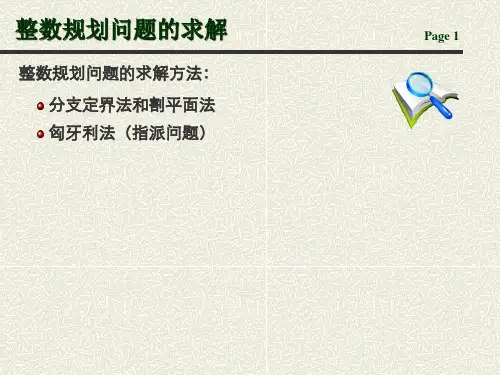
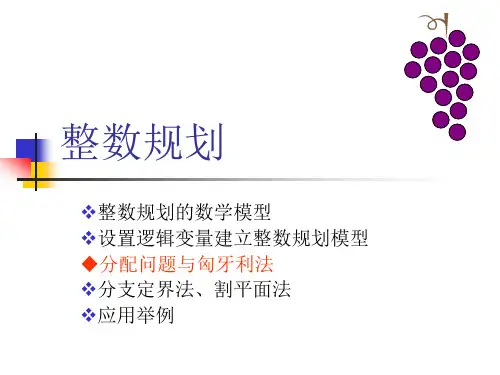
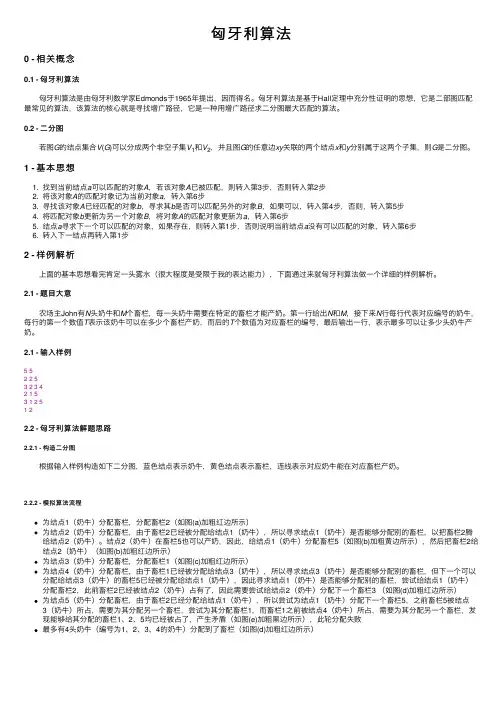
匈⽛利算法0 - 相关概念0.1 - 匈⽛利算法 匈⽛利算法是由匈⽛利数学家Edmonds于1965年提出,因⽽得名。
匈⽛利算法是基于Hall定理中充分性证明的思想,它是⼆部图匹配最常见的算法,该算法的核⼼就是寻找增⼴路径,它是⼀种⽤增⼴路径求⼆分图最⼤匹配的算法。
0.2 - ⼆分图 若图G的结点集合V(G)可以分成两个⾮空⼦集V1和V2,并且图G的任意边xy关联的两个结点x和y分别属于这两个⼦集,则G是⼆分图。
1 - 基本思想1. 找到当前结点a可以匹配的对象A,若该对象A已被匹配,则转⼊第3步,否则转⼊第2步2. 将该对象A的匹配对象记为当前对象a,转⼊第6步3. 寻找该对象A已经匹配的对象b,寻求其b是否可以匹配另外的对象B,如果可以,转⼊第4步,否则,转⼊第5步4. 将匹配对象b更新为另⼀个对象B,将对象A的匹配对象更新为a,转⼊第6步5. 结点a寻求下⼀个可以匹配的对象,如果存在,则转⼊第1步,否则说明当前结点a没有可以匹配的对象,转⼊第6步6. 转⼊下⼀结点再转⼊第1步2 - 样例解析 上⾯的基本思想看完肯定⼀头雾⽔(很⼤程度是受限于我的表达能⼒),下⾯通过来就匈⽛利算法做⼀个详细的样例解析。
2.1 - 题⽬⼤意 农场主John有N头奶⽜和M个畜栏,每⼀头奶⽜需要在特定的畜栏才能产奶。
第⼀⾏给出N和M,接下来N⾏每⾏代表对应编号的奶⽜,每⾏的第⼀个数值T表⽰该奶⽜可以在多少个畜栏产奶,⽽后的T个数值为对应畜栏的编号,最后输出⼀⾏,表⽰最多可以让多少头奶⽜产奶。
2.1 - 输⼊样例5522532342153125122.2 - 匈⽛利算法解题思路2.2.1 - 构造⼆分图 根据输⼊样例构造如下⼆分图,蓝⾊结点表⽰奶⽜,黄⾊结点表⽰畜栏,连线表⽰对应奶⽜能在对应畜栏产奶。
2.2.2 - 模拟算法流程为结点1(奶⽜)分配畜栏,分配畜栏2(如图(a)加粗红边所⽰)为结点2(奶⽜)分配畜栏,由于畜栏2已经被分配给结点1(奶⽜),所以寻求结点1(奶⽜)是否能够分配别的畜栏,以把畜栏2腾给结点2(奶⽜)。
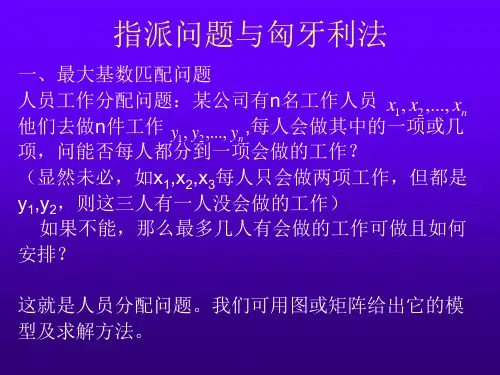

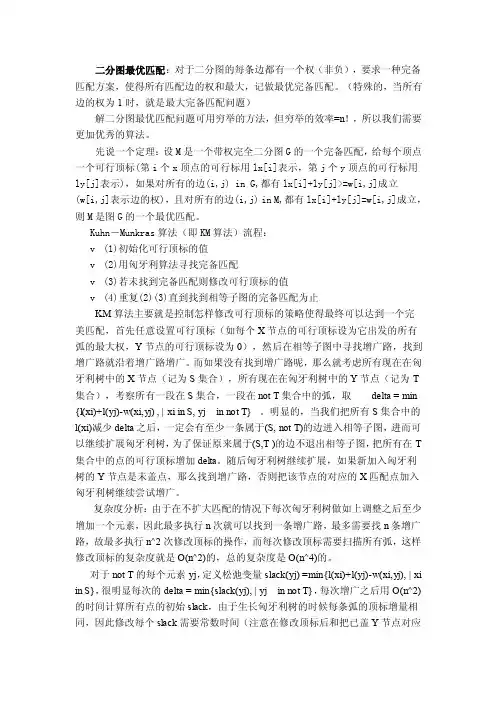
二分图最优匹配:对于二分图的每条边都有一个权(非负),要求一种完备匹配方案,使得所有匹配边的权和最大,记做最优完备匹配。
(特殊的,当所有边的权为1时,就是最大完备匹配问题)解二分图最优匹配问题可用穷举的方法,但穷举的效率=n!,所以我们需要更加优秀的算法。
先说一个定理:设M是一个带权完全二分图G的一个完备匹配,给每个顶点一个可行顶标(第i个x顶点的可行标用lx[i]表示,第j个y顶点的可行标用ly[j]表示),如果对所有的边(i,j) in G,都有lx[i]+ly[j]>=w[i,j]成立(w[i,j]表示边的权),且对所有的边(i,j) in M,都有lx[i]+ly[j]=w[i,j]成立,则M是图G的一个最优匹配。
Kuhn-Munkras算法(即KM算法)流程:v(1)初始化可行顶标的值v(2)用匈牙利算法寻找完备匹配v(3)若未找到完备匹配则修改可行顶标的值v(4)重复(2)(3)直到找到相等子图的完备匹配为止KM算法主要就是控制怎样修改可行顶标的策略使得最终可以达到一个完美匹配,首先任意设置可行顶标(如每个X节点的可行顶标设为它出发的所有弧的最大权,Y节点的可行顶标设为0),然后在相等子图中寻找增广路,找到增广路就沿着增广路增广。
而如果没有找到增广路呢,那么就考虑所有现在在匈牙利树中的X节点(记为S集合),所有现在在匈牙利树中的Y节点(记为T 集合),考察所有一段在S集合,一段在not T集合中的弧,取delta = min {l(xi)+l(yj)-w(xi,yj) , | xi in S, yj in not T} 。
明显的,当我们把所有S集合中的l(xi)减少delta之后,一定会有至少一条属于(S, not T)的边进入相等子图,进而可以继续扩展匈牙利树,为了保证原来属于(S,T )的边不退出相等子图,把所有在T 集合中的点的可行顶标增加delta。
随后匈牙利树继续扩展,如果新加入匈牙利树的Y节点是未盖点,那么找到增广路,否则把该节点的对应的X匹配点加入匈牙利树继续尝试增广。
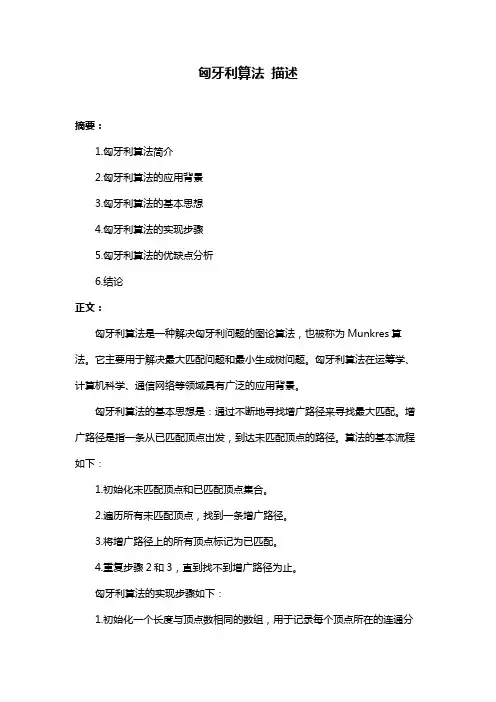
匈牙利算法描述
摘要:
1.匈牙利算法简介
2.匈牙利算法的应用背景
3.匈牙利算法的基本思想
4.匈牙利算法的实现步骤
5.匈牙利算法的优缺点分析
6.结论
正文:
匈牙利算法是一种解决匈牙利问题的图论算法,也被称为Munkres算法。
它主要用于解决最大匹配问题和最小生成树问题。
匈牙利算法在运筹学、计算机科学、通信网络等领域具有广泛的应用背景。
匈牙利算法的基本思想是:通过不断地寻找增广路径来寻找最大匹配。
增广路径是指一条从已匹配顶点出发,到达未匹配顶点的路径。
算法的基本流程如下:
1.初始化未匹配顶点和已匹配顶点集合。
2.遍历所有未匹配顶点,找到一条增广路径。
3.将增广路径上的所有顶点标记为已匹配。
4.重复步骤2和3,直到找不到增广路径为止。
匈牙利算法的实现步骤如下:
1.初始化一个长度与顶点数相同的数组,用于记录每个顶点所在的连通分
量。
2.遍历所有边,对于每条边,如果两个顶点不在同一连通分量,则将它们合并到同一个连通分量中。
3.遍历所有顶点,如果一个顶点所在的连通分量只有一个顶点,则将其标记为已匹配。
4.重复步骤3,直到找不到未匹配顶点为止。
匈牙利算法的优缺点分析:
优点:
1.匈牙利算法的时间复杂度为O(nm),其中n和m分别为顶点数和边数。
2.匈牙利算法可以保证找到最大匹配。
缺点:
1.匈牙利算法需要额外的存储空间来记录顶点所在的连通分量。
2.匈牙利算法不能保证找到最优解,因为可能存在多个最大匹配。